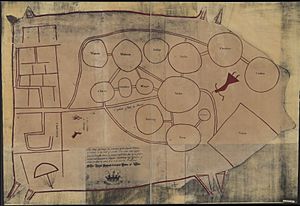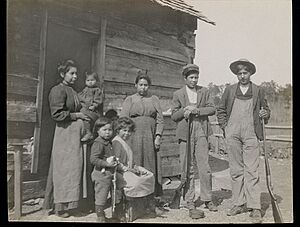Catawba people facts for kids
| Ye Iswąˀ | |
|---|---|
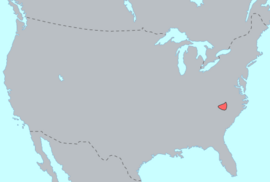
Pre-contact distribution of the Catawba
|
|
| Total population | |
| 2010: 3,370 | |
| Regions with significant populations | |
| Languages | |
| English, formerly Catawba | |
| Religion | |
| Traditional Indigenous (private), Christianity (incl. syncretistic forms), Mormon | |
| Related ethnic groups | |
| Lumbee, Waccamaw, Eno, Shakori, and other Siouan peoples |
|
Catawba Reservation
|
|
|---|---|

Location in South Carolina
|
|
| Tribe | Catawba Nation |
| Country | United States |
| State | South Carolina |
| County | York |
| Headquarters | Rock Hill |
| Population
(2010)
|
|
| • Total | 3,370 |
| Website | catawba.com |
The Catawba people, also known as Iswa (meaning "people of the river" in their language), are a Native American tribe. They are officially recognized by the United States government as the Catawba Indian Nation. Their main lands today are in South Carolina, along the Catawba River, near Rock Hill, South Carolina. Long ago, their territory also reached into North Carolina.
The Catawba were once a very strong tribe in the Carolina Piedmont region. Smaller tribes often joined them as their own numbers went down after Europeans arrived. The Catawba sometimes made friends with early European settlers. These alliances helped them in fights against other tribes. These rival tribes included the Iroquois, Shawnee, Lenape, and Cherokee. These groups often fought over hunting lands, especially in the Ohio Valley.
During the American Revolutionary War, the Catawba supported the American colonists. Sadly, many Catawba people died from diseases like smallpox brought by Europeans. Warfare and changes to their way of life also caused their population to shrink. Some Catawba stayed in South Carolina, while others briefly joined the Choctaw or Cherokee tribes.
In 1959, the U.S. government stopped recognizing the Catawba as a tribe. This was part of a policy called "termination." But the Catawba worked hard to get their tribal rights back. In 1973, they started enrolling members again. By 1993, they were officially recognized by the federal government once more. They also won a $50 million settlement for their land claims. This money helps them with economic growth.
As of 2006, the Catawba Nation had about 2,600 members. Most of them live in South Carolina. The Catawba language, which is part of the Siouan language family, is now being brought back to life.
Contents
What's in a Name?
The Catawba people have also been called Esaw or Issa. These names come from the Catawba word iswä, which means "river." This name refers to their home along the main river in their area. Today, this river is known as the Catawba River. It flows from North Carolina into South Carolina. The Iroquois tribes often called the Catawba by a general name, Totiri or Toderichroone.
A Look Back: Catawba History
People have lived in the Catawba River area for a very long time. Evidence of ancient pottery shows that people were there during the Woodland period. The Catawba were the main people living there when the first Europeans arrived.
In the late 1800s, a researcher named Henry Rowe Schoolcraft thought the Catawba had once lived in Canada. He believed they were forced south by the Iroquois. However, another anthropologist, James Mooney, later said this idea was wrong. He found that the Spanish explorer Juan Pardo had recorded the Catawba living in the same river area as early as 1567. This shows they have lived there for a very long time.
The Catawba often had conflicts with tribes from the north. These included the Seneca nation (part of the Haudenosaunee) and the Lenape people. They all competed for hunting grounds and land. The Catawba would sometimes chase Lenape raiding parties far north, even across the Potomac River.
In 1721, leaders from Virginia and New York held a meeting in Albany, New York. They brought together the Iroquois Confederacy and the Catawba. The colonists wanted peace between these powerful tribes. The Iroquois agreed to keep the land west of the Blue Ridge mountains for themselves. This area included a major trail used by warriors.
Challenges and Changes
In 1738, a terrible smallpox epidemic hit South Carolina. This disease, brought by Europeans, caused many deaths among the Catawba and other tribes. In 1759, another smallpox outbreak killed almost half of the Catawba people.
In 1744, the Treaty of Lancaster was signed. This treaty helped create peace between the Iroquois and the colonists. The Iroquois had claimed the Ohio Valley as their hunting ground. This treaty helped stop some of the fighting. However, tribes to the west continued to fight the Catawba. In 1763, a small group of Shawnee killed the well-known Catawba chief, King Hagler, near his village.
In 1763, the South Carolina government set aside a reservation for the Catawba. This land was about 225 square miles and was on both sides of the Catawba River. During the American Revolutionary War in 1780, the Catawba temporarily moved to Virginia. They returned after the Battle of Guilford Court House. They settled in two villages on their reservation: Newton and Turkey Head.
The 1800s
By 1826, the Catawba were struggling. They leased almost half of their reservation land to white settlers for a small yearly payment. This money was important for their survival, as their numbers had become very small.
In 1840, the Catawba signed the Treaty of Nation Ford with South Carolina. They sold almost all of their land to the state, keeping only one square mile. This treaty was not legal because only the federal government could make such agreements with tribes. Around this time, some Catawba people moved to join the Cherokee in North Carolina. But they found it hard to live among their former enemies and soon returned to South Carolina. A few Catawba also moved to the Choctaw Nation of Oklahoma in Indian Territory (now Oklahoma). They blended in with the Choctaw and did not keep their separate tribal identity.
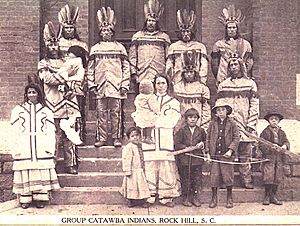
During the American Civil War, 19 Catawba men joined the Confederate Army. They fought in battles across Virginia.
Traditional Life and Population Changes
Historically, the Catawba were farmers. They also fished and hunted for food like deer. Their customs were similar to other Native American groups in the Piedmont region. Catawba women are especially known for making beautiful pottery and baskets. They still keep these arts alive today. Their pottery tradition is believed to be one of the oldest in North America.
Early Spanish explorers in the mid-1500s thought the Catawba population was between 15,000 and 25,000 people. When the English first settled South Carolina around 1682, they estimated about 4,600 Catawba people. Their numbers dropped sharply because of diseases like smallpox. By 1728, there were only about 1,400 Catawba people. In 1759, smallpox hit again, and by 1761, their population was around 1,000. By 1784, only 250 Catawba people were reported. Their numbers continued to fall in the 1800s, reaching a low of 110 people in 1826. However, by 2006, their population had grown to about 2,600.
Beliefs and Culture
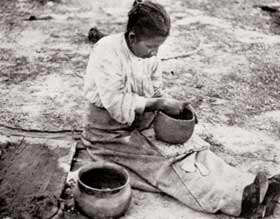
An anthropologist named Frank Speck studied the Catawba's customs and beliefs in the 1900s. The Catawba are well known for their pottery, which was traditionally made by women. Today, some men also make pottery.
Around 1883, missionaries from the Church of Jesus Christ of Latter-day Saints visited the tribe. Many Catawba people became members of the church. Some even moved to Utah, Colorado, and other western states to live with other Mormons.
The Catawba people on their reservation in South Carolina have a yearly celebration called Yap Ye Iswa. This means "Day of the People" or "Day of the River People." It is held at the Catawba Cultural Center. The money raised helps support the center's activities.
From the 1900s to Today
The Catawba people were electing their chiefs even before the 1900s. In 1909, they asked the United States government for U.S. citizenship.
During President Franklin D. Roosevelt's time, the government tried to help Native Americans. The Indian Reorganization Act of 1934 encouraged tribes to restart their own governments. The Catawba were not recognized as a tribe then because they had lost their land. In 1929, Chief Samuel Taylor Blue began the process to gain federal recognition.
The Catawba were officially recognized by the federal government in 1941. They wrote their own constitution in 1944. Also in 1944, South Carolina gave citizenship to the Catawba and other Native Americans in the state. However, they were not allowed to vote until the late 1960s. This changed after the federal Voting Rights Act of 1965 was passed.
In the 1950s, the federal government started a policy called "Indian termination." They believed some tribes no longer needed a special relationship with the government. So, the Catawba's government was ended in 1959. This stopped federal help, and their shared tribal land was divided among individual families. The Catawba then became subject to state laws.
The Catawba people decided they wanted to be organized as a tribal community again. In 1973, they began working to get their government federally recognized. Gilbert Blue served as their chief until 2007. They created a new constitution in 1975, based on their 1944 version.
For many years, the Catawba also fought for their land rights. They argued that the 1840 treaty with South Carolina was illegal. The U.S. Supreme Court ruled that the tribe's land claims were still valid. The Catawba then planned to file many lawsuits against landowners in York County. To avoid this, the U.S. Congress passed the Catawba Indian Tribe of South Carolina Land Claims Settlement Act of 1993. This law officially recognized the Catawba Indian Nation again. It also settled the land claims for $50 million, which helps the Nation with economic growth.
On July 21, 2007, the Catawba held their first elections in over 30 years.
In the 2010 census, 3,370 people said they had Catawba family roots.
Catawba Indian Nation Land and Future
The Catawba Reservation is located in two separate parts in York County, South Carolina, east of Rock Hill. It covers about 1,012 acres. In 2010, 841 people lived there. The Catawba also have a special service area in North Carolina. This area includes several counties like Mecklenburg and Cabarrus. The Catawba also own a 16.57-acre site in Kings Mountain, North Carolina. They plan to build a casino and entertainment complex there.
Today, the Catawba Nation gets most of its money from federal and state funds.
Gaming and South Carolina
When the 1993 Settlement Act was signed, the Catawba agreed to follow South Carolina's rules for games of chance. At that time, these rules allowed for video poker and bingo. In 1996, the Catawba partnered with a company to manage their bingo and casino operations. They ran a bingo hall in Rock Hill. In 1999, South Carolina banned video poker machines across the state.
In 2002, South Carolina started its own lottery. This caused the tribe to lose money from their bingo hall. So, they closed the Rock Hill bingo operation in 2006 and sold the building in 2007.
The Catawba sued South Carolina for the right to operate video poker. They won in lower courts, but the state appealed. The South Carolina Supreme Court overturned the ruling. The tribe tried to appeal to the Supreme Court of the United States, but the court refused to hear the case in 2007. This meant the state's decision stood. In 2014, the South Carolina Supreme Court also ruled against the tribe regarding gambling cruises.
In 2014, the Catawba tried again to open a bingo hall in Rock Hill. But it closed in 2017 because it could not make a profit.
Gaming and North Carolina
On September 9, 2013, the Catawba announced plans for a large casino in Kings Mountain, North Carolina. This casino would cost $600 million. Local officials in Cleveland County supported the idea. However, North Carolina's Governor Pat McCrory and the Eastern Band of Cherokee Indians (EBCI) were against it.
The Catawba asked the United States Department of the Interior (DOI) to put the land in trust for them in 2013, but this was denied in 2018. They tried again in September 2018. They also tried to get a bill passed in Congress to help them.
On March 13, 2020, the DOI approved the Catawba's request to put the North Carolina land in trust. This meant the tribe could build their casino. The EBCI quickly filed a lawsuit to challenge this decision. The Catawba joined the lawsuit to defend the DOI's decision. The Cherokee Nation of Oklahoma also joined the lawsuit to support the EBCI.
In May 2020, the EBCI updated their lawsuit. They claimed the DOI's approval was influenced by a casino developer. They also said the DOI did not properly check the environmental impact. The Cherokee Nation of Oklahoma also wanted to protect cultural items on the land where the casino was planned.
On January 24, 2021, North Carolina Governor Roy Cooper signed an agreement with the Catawba Nation. This agreement allows for casino games and betting on sports and horse racing. This agreement is similar to one the state has with the EBCI. On March 19, the Bureau of Indian Affairs approved the agreement. On April 16, a federal judge ruled in favor of the Catawba Nation in the lawsuit. The Catawba Two Kings Casino opened on July 1, 2021. It started with a temporary building that had 500 slot machines in Kings Mountain.
As of 2006[update], the population of the Catawba Nation has increased to about 2,600, most in South Carolina.
Images for kids
See also
 In Spanish: Catawba para niños
In Spanish: Catawba para niños


